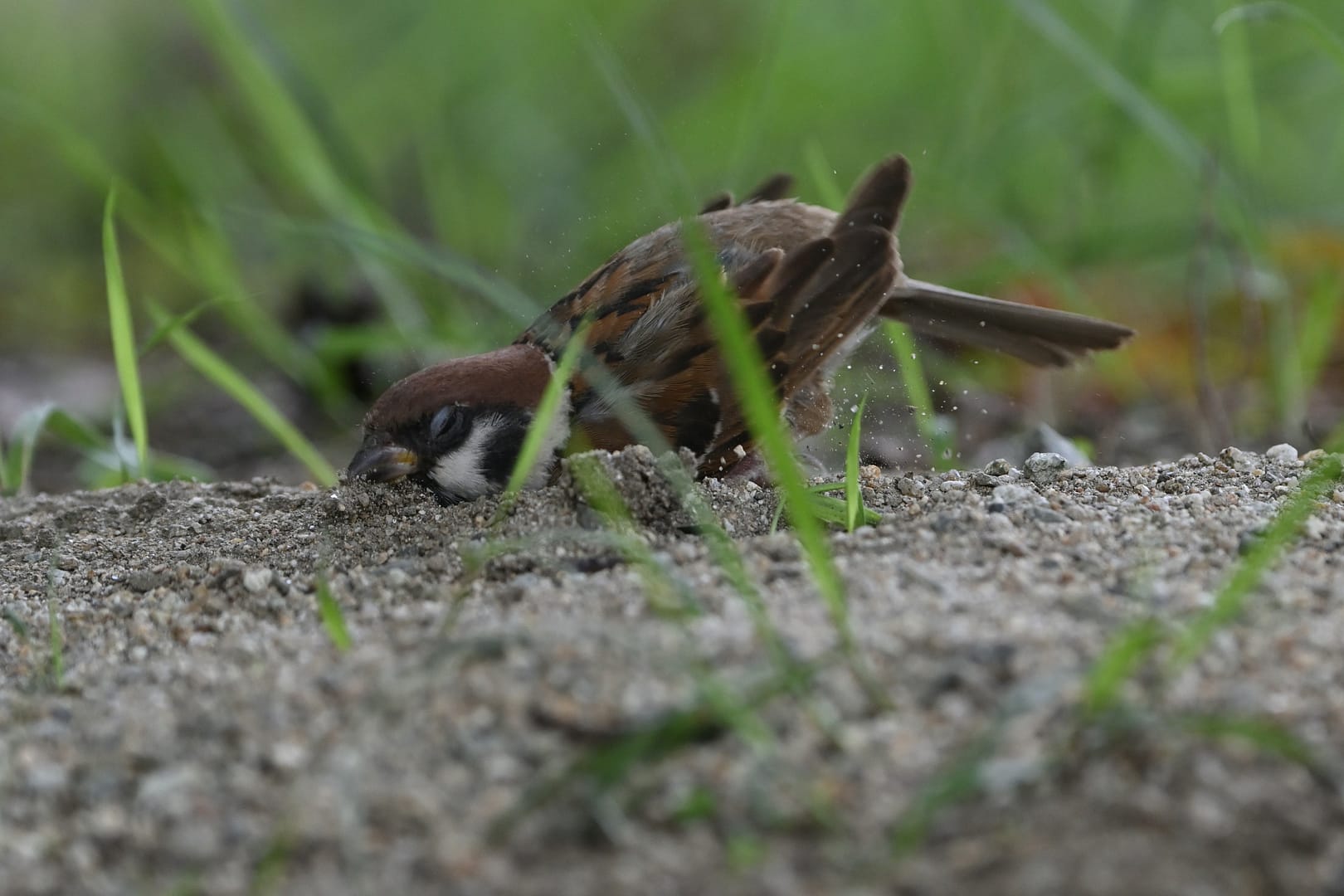Dust bathing is an essential and instinctual behavior among chickens, contributing significantly to their overall health and well-being. This natural behavior serves multiple purposes, ranging from hygiene and skin care to social interaction and temperature regulation. Understanding the significance of dust bathing is crucial for maintaining the welfare of these avian creatures.
Keep reading for more information on why chickens dustbathe, the benefits of doing so, and how you can create dustbathing areas for your chickens.
Why do chickens dustbathe?
While we typically consider dirt to be, well…. dirty,
- Hygiene and Pest Control: One primary function of dust bathing for chickens is hygiene maintenance. Chickens coat themselves in dry soil or dust, effectively removing dirt, excess oils, and dead skin from their feathers and skin. Moreover, this behavior aids in pest control by suffocating and removing parasites like mites and lice, contributing to the overall health of the flock.
- Feather and Skin Health: Dust bathing is vital for preserving the health of a chicken’s feathers and skin. The action of dust bathing assists in conditioning and protecting the feathers, ensuring they remain clean, smooth, and well-maintained. Additionally, the fine dust particles can penetrate the feathers and reach the skin, promoting skin health and reducing the risk of dermatological issues.
- Temperature Regulation: Beyond hygiene, dust bathing plays a role in temperature regulation. In warmer climates, dust bathing helps chickens stay cool by absorbing excess moisture and heat from their bodies. Conversely, in colder environments, the insulating properties of the dust can help provide warmth by trapping heat close to the skin.
- Behavioral Satisfaction and Social Interactions: Dust bathing is not merely a practical activity; it fulfills a chicken’s behavioral needs and provides a sense of satisfaction and pleasure. It’s a natural instinct deeply rooted in their behavior. Moreover, dust bathing can be a social activity within a flock, fostering bonds between chickens as they engage in this shared behavior.
How old are chickens when they start dustbathing?
Chickens typically start dust bathing at a relatively young age, often within a few weeks after hatching. Chicks as old as a couple days may already begin to dustbathe. It’s an action that’s part of a chickens genetic engineering and they know how to do it without being taught by another chicken. While not all chicks will dustbathe at an early age, you’re bound to have a couple and typically all adult chickens will dustbathe on a regular basis.
What does a dustbathing chicken look & sound like?
While it might seem like it would be obvious, many first-time chicken owners are surprised or taken aback when they first witness their chickens dustbathing. Chickens will typically find a dusty or dirty patch of ground, will lay down either straight or leaning side-ways a bit. They will often stretch out their hind legs and will flap their wings while keeping them close to their body to make dirt and debris cover their body and in-between their feathers.
Whenever I’ve had young chicks dust bathe, they’ll often make a squeaky wheel sound. Adult chickens typically don’t make too much noise while their dustbathing (besides the flapping wing sounds).
How often do chickens dustbathe?
Chickens tend to dust bathe regularly as part of their grooming routine and overall behavioral needs. The frequency of dust bathing can vary among individual chickens and can also be influenced by environmental factors, such as weather conditions, and availability of suitable dusting materials.
On average, chickens may engage in dust bathing several times a week, if not daily, especially when conditions are optimal. They often show a preference for dust bathing during the warmer parts of the day when the sun is out and the ground is dry. However, individual preferences and flock dynamics can also play a role in how frequently different chickens dust bathe.
Some chickens may dust bathe more frequently than others, while factors like stress, health issues, or limited access to suitable dusting areas might reduce the frequency of dust baths for certain birds.
Encouraging dust bathing
In general, dust bathing is innate to chickens and doesn’t necessarily have a specific age of onset; rather, it emerges as soon as they have access to suitable materials and environmental conditions that prompt them to engage in this natural grooming behavior. Once they are introduced to appropriate materials, such as dry soil, sand, or dust, they will begin to instinctively exhibit dust bathing behavior.
While you typically won’t need to encourage dustbathing, if for some reason you think your chickens aren’t dustbathing enough or want to help them out, here are some ways to encourage the activity:
- Provide suitable materials: Offer dry soil, sand, or dust in an accessible area within their coop or run. Ensure it’s in a shaded spot to prevent it from becoming too hot in sunny weather.
- Choose the right substrate: Chickens prefer fine, loose soil or dust that allows them to easily coat their feathers. Sand, fine dirt, or specially purchased poultry dusting material works well.
- Maintain a dry environment: Ensure the area for dust bathing remains dry. Wet or muddy areas won’t be appealing to chickens for dust bathing.
- Create a dedicated dust bathing area: Designate a specific spot within the coop or run for dust bathing. You can use a shallow box, tray, or even a dedicated area filled with suitable dusting material.
- Provide enough space: Ensure there’s enough space for all chickens to dust bathe comfortably without overcrowding or competition for the dusting area.
- Encourage natural behavior: Encourage dust bathing by mimicking natural conditions. Incorporate natural features like tree branches or shrubs that create shade and help chickens feel more secure while dust bathing.
- Lead by example: Sometimes, demonstrating dust bathing behavior to young chickens by gently sprinkling dust on their backs can encourage them to start on their own.
- Regular maintenance: Periodically refresh or replace the dusting material to maintain its dryness and attractiveness for dust bathing.
How to create a dustbathing area for your chickens
Chickens generally aren’t too picky and are liable to find their own dustbathing spots throughout your yard whether it be a patch of grass-free dirt, a potted plant, or a sandbox. But creating a dedicated dust bathing area for chickens involves setting up a suitable space that encourages and facilitates this natural behavior (and might keep them out of your potted plants).
- Choose the location: Select a spot within the chicken coop or run that provides some shade and protection from direct sunlight and adverse weather conditions. Ensure it’s an area where chickens feel comfortable and secure.
- Prepare the area: Clear the chosen spot of debris, rocks, or sharp objects that could potentially harm the chickens while dust bathing.
- Select the substrate: Choose an appropriate material for dust bathing, such as fine dirt, sand, or specially formulated poultry dusting material. Make sure it’s fine enough for chickens to easily coat their feathers. Chickens aren’t picky, so simply mixing together what you have on hand, whether it be sand, or dirt, or leftover soot from a burn pile, most similar substrates will do. Just make sure that they are safe for your chickens to be around and potentially eat/inhale.
- Create a dusting box or area: You can use various containers or structures to create the dust bathing area. Options include:
- Shallow boxes or trays: Fill them with the chosen dusting material.
- Tire rim or wooden frame: Build a low-sided frame filled with the dusting material.
- Designated area: Section off a part of the ground, ensuring it’s slightly concave for easy dust bathing.
- Fill the area with dusting material: Pour or spread the chosen substrate into the designated area or container. Ensure there’s enough material for chickens to comfortably bathe in and cover themselves.
- Introduce chickens to the area: Initially, chickens might need some encouragement to use the designated dust bathing area. You can gently place some chickens into the area or sprinkle a bit of feed or treats there to pique their interest. Most of the time they’ll figure it out on their own after a bit.
- Monitor and maintain: Regularly check and maintain the dust bathing area. Refresh or replace the dusting material as needed to keep it dry and appealing for the chickens.
Other animals that dustbathe
Several animals across different species engage in dust bathing as a means of grooming, hygiene maintenance, and thermoregulation. Some of these animals include:
- Chinchillas: These small rodents have dense fur and take dust baths to maintain their coat’s cleanliness and remove excess oil.
- Pigs: Pigs enjoy wallowing in mud, which serves a similar purpose to dust bathing. They coat themselves in mud to cool off, protect their skin from sunburn, and remove parasites.
- Other birds & parrots: Some other bird species, like songbirds and parrots also engage in dust bathing to maintain their plumage and remove parasites. They flutter and roll in dry soil or dust to clean their feathers and remove excess oil.
- Elephants: Elephants take mud baths, coating themselves in mud to protect their skin from the sun’s harsh rays and to cool off. The mud also acts as a natural insect repellent.
- Rhinos: Similar to elephants, rhinos wallow in mud or fine soil, forming a layer of protective coating on their skin that helps prevent sunburn and repels insects.


